I've been thinking about dolphins a lot lately...I don't know why...
I like dolphins and they don't care...but I still like them because they are cool and swim close to the shore and are indicators of the ocean's health..in my book anyway...same with the pelicans..see this one riding the surf?? what's cooler than that?
so I was concerned when reports of thousands of dead dolphins and pelicans washed up on shore in Peru...what's happeneing off the coast of Peru..as a matter of fact where is Peru?
I perused google to find out..oh it's over there by Brazil in South America..I knew that..right around the Tropic of Capricorn..Machu Picchu..Incas...I knew that...
but it's the south Pacific ocean...I'm thinking if there's some islands there they might be restoring by poisoning and killing invasive species the result could be seen in the dolphins and other creatures....
there's the Galapagos of course..and Easter Island....
it seems there's a continual restoration effort on the Galapagos....they dropped rat poison to kill rodents like they did on Anacapa Island....in other words they are using pesticides liberally to cleanse the islands of inferior species
10 tons of brodifacoum
Toxicity:Very highly toxic to aquatic organisms.
Very highly toxic to mammals and birds. Brodifacoum is extremely dangerous to birds through secondary exposure, especially raptors feeding on poisoned rats and mice. Hundreds of avian and other wildlife mortalities have been reported across North America.
The Galapagos Islands. In early January 2011, the first phase of the Galapagos Restoration Project began when the islands' National Park Service, aided by Bell Labs and several other partner organizations, began to eradicate non-native rats that were threatening the islands' seabirds and other creatures. Those other partners included Island Conservation of Santa Cruz, Calif., the Charles Darwin Foundation, the University of Minnesota Raptor Center and the Durrell Wildlife Conservation Trust.
"Since the 1970s, small-scale rodent control efforts had been underway there, but the baiting drop, which involved 10 tons of brodifacoum, is the first step for the Galapagos Restoration Project's new ongoing management system," Martin said. "The system involves a planned 20- to 25-year process to permanently rid the islands of non-native rats."
Bait used in the various island conservation projects is specially formulated to meet the unique climate conditions of each location, Martin said. "The bait needs to last six or seven days to make certain each rat on an island is exposed to it and consumes it. The South Georgia Island bait was formulated to be effective for that time period under wet conditions," he said, "while bait used on the Galapagos Islands was designed for arid conditions."
Is it Ever OK to Use Brodifacoum?
 American Bird Conservancy continues to oppose to the use of brodifacoum by the public, and further, has serious questions about outdoor uses in most situations. However, occasions may arise in which the use of brodifacoum can be critical to protecting endangered and/or migratory bird species, e.g., in island situations to protect birds imperiled by rodent predation. Integrated pest management strategies must be in place, however, and careful monitoring must accompany use...
American Bird Conservancy continues to oppose to the use of brodifacoum by the public, and further, has serious questions about outdoor uses in most situations. However, occasions may arise in which the use of brodifacoum can be critical to protecting endangered and/or migratory bird species, e.g., in island situations to protect birds imperiled by rodent predation. Integrated pest management strategies must be in place, however, and careful monitoring must accompany use...
no no no...there is no reason at all to poison islands..none at all...these lame restorations by non-profits from the Nature Conservancy to the Center for Biological Diversity and gov't agencies using tax money are a scam...
you can kill the weeds, but you can't kill the seeds


No comments:
Post a Comment